Bohemian Dining Tables: A Blend of Style and Function
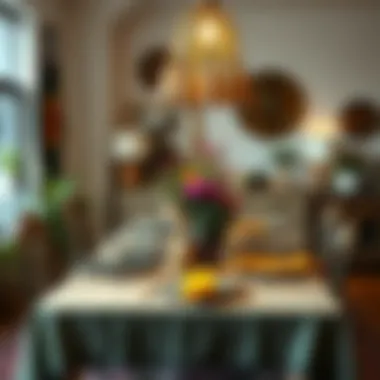
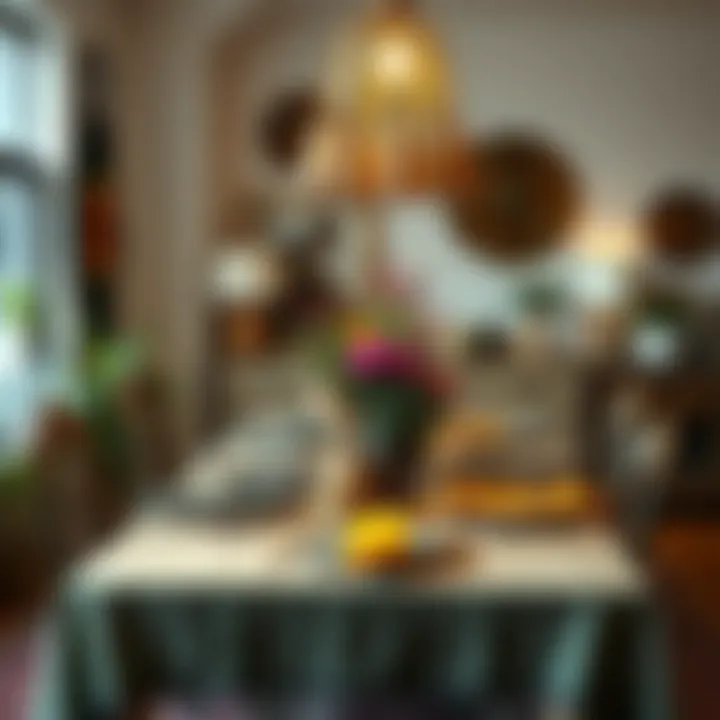
Intro
In the realm of interior design, dining tables hold a unique place, embodying not just functionality but also style. Among the myriad of design choices, bohemian dining tables stand out with their eclectic charm and vibrant spirit. With roots steeped in freedom and creativity, these tables are more than just physical objects; they are conversation starters, cultural artifacts, and symbolic representations of a lifestyle choice that embraces diversity and artistic expression.
The bohemian style is characterized by its rich mix of textures, colors, and materials. Picture a table that exudes warmth, draped in a kaleidoscope of fabrics, perhaps adorned with handmade pottery and lively greenery. Such a setting invites intimacy and connection, transforming a simple meal into a memorable experience.
As we embark on this exploration, we will dive deep into various facets of bohemian dining tables—from current design trends to practical guidance for incorporating these pieces into your home. Whether you’re a homeowner looking to revamp your space or a designer seeking inspiration, understanding the aesthetics and functionality of bohemian dining tables can significantly enhance your dining environment.
The bohemian style transcends mere decoration; it speaks to a lifestyle that values creativity and individuality. Consequently, learning how to seamlessly incorporate these tables into your dining spaces is essential for anyone wanting to achieve a harmonious balance between beauty and practicality.
Let’s first look at the current design trends that are shaping the world of bohemian dining tables.
Preface to Bohemian Dining Tables
Bohemian dining tables encapsulate a sense of organic charm and artistic freedom. These tables serve more than just the purpose of dining; they become focal points in homes, nurturing gatherings and memories. Understanding the importance of this topic draws attention to the rich narrative behind these designs—where culture, creativity, and comfort intertwine.
From eclectic wood grains to vibrant colors, bohemian dining tables reflect the importance of personal expression. They allow homeowners and designers to showcase individual styles and preferences, fostering a welcoming environment. For those looking to cultivate a relaxed, inviting dining experience, such tables are vital.
Moreover, this discussion goes beyond mere aesthetics. The versatility of bohemian dining tables makes them suitable for various lifestyles and settings, whether one resides in a chic urban apartment or a relaxed suburban home. They resonate especially well with DIY enthusiasts and retailers, who can tailor pieces to fit specific needs or tastes.
Incorporating a bohemian dining table into one’s home can enhance not only visual appeal but also functionality. It allows for flexible seating arrangements, as these tables often come in various shapes and sizes—further blending practicality with beauty. Considerations around material, color, and arrangement also come into play, making the selection an engaging process.
"Bohemian design is not just a style; it’s a lifestyle that embraces warmth, creativity, and the art of living well."
Ultimately, this exploration of bohemian dining tables serves to educate and inspire. It highlights the rich textures, cultural influences, and practicalities that shape these unique furnishings, inviting readers to consider ways they can enrich their own dining spaces. An in-depth understanding of the many facets of bohemian tables can lead to thoughtful selections that resonate with one’s lifestyle and aesthetic goals.
Defining the Bohemian Aesthetic
Understanding the bohemian aesthetic is crucial when diving into the world of bohemian dining tables. This style is not just about quirky patterns or vibrant colors; it's a lifestyle choice that reflects freedom, individuality, and a certain joyous disregard for convention. At its core, the bohemian aesthetic celebrates a mix of the old and the new, inviting an array of textures, colors, and shapes to coexist harmoniously. More than just design, it speaks to a rich narrative that intertwines cultures, traditions, and personal stories, giving depth to the spaces we inhabit.
Historical Influences
The bohemian style arose from the artistic and cultural movements of the 19th century. Emerging predominantly in Europe, this movement drew inspiration from the nomadic lifestyles of Romani people, the artistic circles in Paris, and the countercultural movements that challenged societal norms. Artists, writers, and free spirits began to reject the rigidity of mainstream culture, leading to a style characterized by its eclectic nature.
The blending of diverse cultural histories plays a significant role in shaping the bohemian aesthetic. For instance, the rich textiles from the Middle East, the artful decor from Africa, and Eastern influences like Tibetan rugs are often reflected in bohemian designs. This historical tapestry not only highlights the importance of cultural exchanges but also creates an aesthetic that feels global and timeless.
Key Features of Bohemian Design
When identifying key features of bohemian design, several elements stand out:
- Eclectic Mix of Elements: Bohemian design encourages a blend of various colors, patterns, and textures. This freedom leads to delightful surprises, as unexpected combinations can come together beautifully.
- Natural Materials: Wood, stone, and metals play a vital role. The emphasis on organic materials adds an innate warmth to dining tables, making them inviting for gatherings.
- Artisanal Touches: Handcrafted items, like unique centerpieces or intricate carvings, are invaluable to the bohemian aesthetic. These elements speak to a greater appreciation for individual craftsmanship.
- Layering: Layering different materials—from textiles like table runners to wall hangings—creates depth and intrigue. This approach stimulates the senses and fosters a cozy, lived-in feel.
- Color Palettes: Warm earth tones, jewel tones, and vibrant accents are staples of bohemian design. Each color complements the other, often drawing from nature.
Adding a little flair goes a long way in achieving that bohemian vibe. Think woven baskets, cushions with ethnic patterns, or even mismatched dining chairs. The goal is to create an atmosphere that feels relaxed and inviting but rich in character.
In summary, defining the bohemian aesthetic is about embracing diversity in design. By understanding its historical roots and distinctive features, homeowners and designers can create dining spaces that reflect individuality while fostering intimacy and connection.
Materials Used in Bohemian Dining Tables
When it comes to bohemian dining tables, the materials are not just about functionality; they scream character. Every piece is a testament to the story behind it. These materials bring life to the table and define its aesthetics and durability. From the intricate grains of wood to the sheen of metal, these materials work together to create an inviting atmosphere, perfect for shared meals and gatherings.
Wood Varieties and Textures
Wood is perhaps the king of materials when talking about bohemian tables. You’ll find a smorgasbord of wood varieties, each adding its own flair. Teak, mango, and reclaimed wood are particularly popular choices.
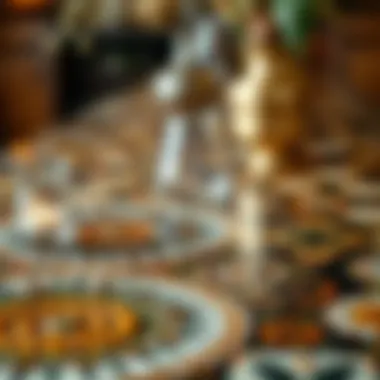

- Teak: Known for its weather resistance and rich, warm tones, teak gives a luxurious feel without being ostentatious. The natural oils in this wood make it ideal for both indoor and outdoor settings, enhancing durability.
- Mango: A more sustainable choice, mango wood is often characterized by unique, swirling patterns. Each piece feels one-of-a-kind, making it a great conversation starter. When left in its natural state, it brings a rustic charm that resonates with bohemian vibes.
- Reclaimed Wood: This type of wood carries a history, often sourced from old barns or buildings. With its knots, stains, and scratches, it shows imperfections that really add to its charm. Using reclaimed wood supports sustainability, adding an eco-friendly touch to your dining space.
Textures also play a significant role. The raw finish, smooth surfaces, and even the occasional distressed style create visual interest. By mixing and matching different textures, you create a table that feels dynamic yet cohesive.
Incorporating Metal and Glass Elements
Metal and glass elements are like the cherry on top when it comes to bohemian dining tables. They can elevate wooden tables into standout pieces. Metal accents can be found in legs or supports, adding a touch of industrial edge to the overall design. Think iron or brass in various finishes. Here’s why they’re often used:
- Contrast: Metal brings an unexpected contrast against warm woods. A sleek, black metal leg can make a rustic wooden top pop, creating eye-catching visuals.
- Durability: Metal parts tend to be resilient, offering stability to tables that may otherwise be wobbly. They can endure wear and tear far better than wood alone.
- Glass: Whether it’s a glass top over wood or incorporated in design, it allows light to play and reflect, adding an airy feel to your dining area. Glass can also serve as a protective layer, making clean-up easier without taking away from the aesthetics.
Textiles and Decorative Accents
Textiles might not be immediately associated with tables, but they’re crucial for creating a bohemian vibe. The interplay of fabrics can soften the look of a dining space while providing comfort. Consider:
- Table Linens: Vibrant table runners or intricate tablecloths can infuse animal prints, florals, or geometric patterns into your dining experience. This provides versatility – you can switch out the fabric to match the season or occasion.
- Cushions: Incorporating cushions on dining chairs invites guests to linger longer. They can be of various patterns and materials, adding layers to your design while enhancing comfort.
- Decorative Accessories: Think of bowls, centerpieces, and trivets made from ceramics or woven materials that mirror the eclectic nature of bohemian design. These accents add color and texture, further drawing together the table’s theme.
"A bohemian dining table is not just a piece of furniture; it’s an experience waiting to happen, filled with vibrance and history."
Together, these elements culminate in a dining table that's far more than merely functional. It becomes a central piece of expression within your home, embodying a blend of culture, artistry, and personal touch. The right materials ensure that the dining area is not just a spot for meals but a canvas for experiences and memories.
Design Considerations for Bohemian Dining Tables
When it comes to creating a vibe that feels both eclectic and welcoming, design considerations for bohemian dining tables play a pivotal role. This isn't just about choosing a table that looks good; it’s about understanding how various elements interplay to create that laid-back yet artistic vibe typical of bohemian décor. The right dining table can serve as the centerpiece of your dining space, influencing not just aesthetics but also functionality and comfort.
In the bohemian realm, where style knows no bounds, consider three core aspects: shape and size, color palettes, and the arrangement of your dining area. Each element has a unique significance that deserves thoughtful examination to ensure a cohesive and inviting environment.
Shape and Size Variability
The shape of a dining table can substantially alter the ambieance of your dining area. Round tables tend to foster a sense of intimacy, making them ideal for smaller spaces or for gatherings where conversation flows freely. Conversely, rectangular tables may establish a more formal atmosphere, suitable for larger gatherings or shared family meals.
- Space: Always measure your dining area before committing to a shape. You want the table to fit snugly without crowding the space. Allow for enough room for chairs to pull out and people to maneuver around them.
- Size: The size should reflect both functionality and the essence of the bohemian aesthetic. A generously-sized table can serve multiple functions—from dining to crafting—while a smaller one can be layered with artistic touches like ceramic objects or a table runner made of handwoven textiles.
Think of your table as a canvas. A well-chosen shape and size not only serve practical purposes but also can reflect your personal story.
Color Palettes and Combinations
Color plays a crucial role in manifesting the bohemian spirit. In this design philosophy, you are free to mix and match hues, often drawing inspiration from nature and cultural influences around the globe.
- Natural Hues: Earthy tones like terracotta, muted greens, and deep browns resonate well and integrate seamlessly with textures of wood and fabric. These colors can reflect comfort and warmth, which is key to the bohemian ethos.
- Vibrancy: Don’t shy away from popping colors! Jewel tones like emerald green, ruby red, or sapphire blue can add life and energy to an otherwise neutral palette. Consider how these colors interact with other furnishings or wall colors in your space.
When combining colors, take care to maintain balance. Too many bold colors can create chaos, whereas too few may dull the unique character you aim to cultivate.
Arranging Dining Spaces for Harmony
Arranging your dining space is akin to orchestrating a symphony. Each element must harmonize with the next to promote the overall aesthetic you hope to achieve.
- Focal Point: Your dining table should be the focal point, so arrange surrounding elements to draw attention to it. This could mean placement of artwork, plants, or decorative lighting right above the table.
- Flow: Consider the natural flow of movement in your dining space. Ensure that there’s enough room for people to move freely around the table and access surrounding areas like sideboards or kitchens.
- Textural Balance: Incorporate different textures through textiles like table runners, placemats, or napkins. Mixing materials—like wood, metal, and fabric—fosters variety and depth in your dining experience.
"Harmony is not a simple concept; it reflects the interplay of various elements that need to be balanced just right for that ideal bohemian dream."
By focusing on these design considerations, you can create a dining space that embodies bohemian charm. Understanding how shape and size, color combinations, and spatial arrangements interact will help you make informed decisions and elevate your home’s atmosphere.
Practical Tips for Choosing a Bohemian Dining Table
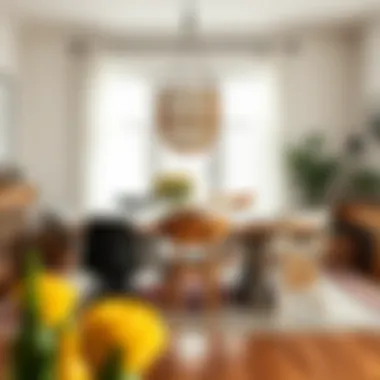
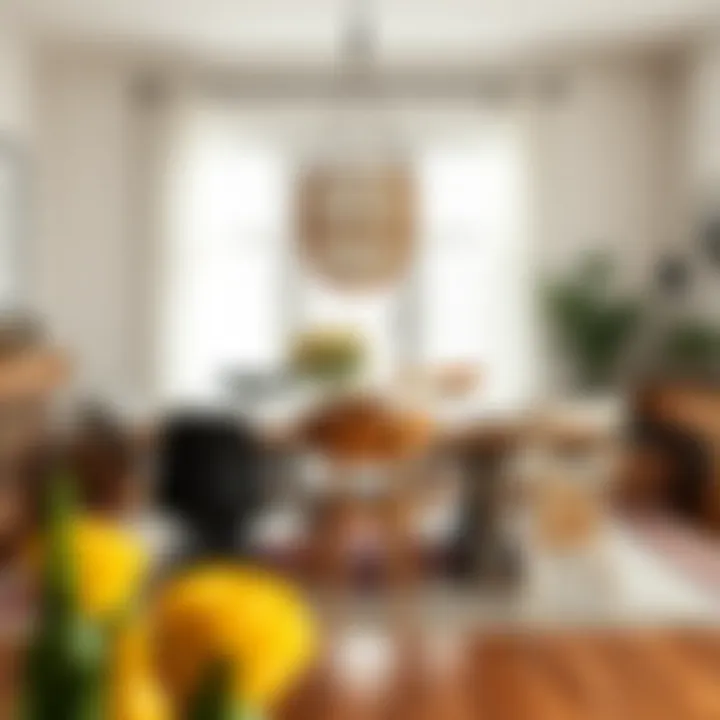
When considering a bohemian dining table, it’s essential to think not only about aesthetics but also about how practical it will be for your day-to-day life. This section dives into helpful advice that ensures your bohemian dining experience marries style with sustainability and functionality. In a world where trends come and go, investing in a table that fits seamlessly into your home while reflecting your personal flair is crucial. Here are some practical tips to navigate this journey.
Assessing Your Dining Area
First and foremost, take a thorough look at your dining area. Think of it as a potential blank canvas where you’d like to paint your unique art piece. Measure the space accurately. You don't want to cram a massive table into a petite nook, nor do you want a smaller table to get lost in a larger room.
- Size Matters: Consider how many people you typically host. A table that fits six people might work wonders if you have regular gatherings, while a cozy setup for two may suit your lifestyle better.
- Shape Consideration: Round tables can create more intimacy, while rectangular ones allow for larger gatherings. If your dining space is narrow, a rectangular table can fit snugly where a round table may not.
- Flow and Movement: Ensure there is enough space around the table for people to move comfortably. A good rule of thumb involves leaving about three feet of space around the table, facilitating ease of movement during meals or gatherings.
Take a moment to visualize the scene. What is the existing aesthetic? How does the table fit into this picture?
Matching With Existing Decor
Once you’ve assessed your dining area, it’s time to think about existing decor. In a bohemian setting, layers often tell a story—each element speaks not just to the overall aesthetic but also to the memories shared around the table.
- Color Coordination: Look closely at the colors present in your dining space. Bohemian style thrives on earth tones, vibrant hues, and eclectic patterns. Match or compliment these shades in your table setting.
- Material Harmony: If your home features wooden elements, a table with a reclaimed wood finish can create a delightful continuity. Similarly, if metal accents or textiles play a vital role in your decor, reflect that in your choice.
- Decorative Elements: Think about how your table will interact with your surroundings. Will it stand alone like a centerpiece or coexist with other decor items?
Balancing all these components ensures that your bohemian table elevates rather than disrupts your space, creating a cohesive dining environment.
Evaluating Durability and Maintenance
Finally, durability and maintenance should not be overlooked. Selecting a bohemian dining table means considering how it will stand up to the rigors of everyday life, especially if you have children or pets.
- Material Resilience: Certain materials wear better than others. Solid wood generally holds up nicely over time, while softer woods like pine may dent more easily.
- Finish and Protection: Look for tables treated with finishes that can resist stains or scratches. A table crafted with a durable varnish can handle both spills during dinner and the inevitable wear and tear of life.
- Cleaning Ease: Consider how easy it is to maintain the table's appearance. Materials that require minimal upkeep may be more suitable for those with busy lifestyles.
In the end, your choice of a bohemian dining table should reflect who you are, while also providing a functional space. Keep the practicality in mind, and don’t shy away from mixing your tastes; a table can be a statement piece while blending harmony into your daily life.
"Choosing the right dining table is much more than picking a piece of furniture; it's about creating a space that tells your story."
Explore more about the bohemian lifestyle and decor options at Wikipedia or gain insights from communities on Reddit where users share their experiences and ideas.
Influences on Contemporary Bohemian Dining Table Design
The contemporary design of Bohemian dining tables is not merely a window dressing; it reflects a rich tapestry woven from various cultural threads. This section dives into how modern influences are transforming bohemian aesthetics, blending them with other styles and offering a fresh perspective on functionality and form.
Cultural Fusions in Design
Cultural intersection has become a hallmark of modern bohemian dining table designs. Today, designers pull from a myriad of global influences to create pieces that feel both unique and familiar. Elements from Moroccan, Indian, and even Scandinavian styles are making their way into Bohemian designs, creating items that are as diverse as the cultures they signify.
For instance, consider a dining table that pairs the intricate carvings typical in Indian design with the sleek lines of a Scandanavian minimalist approach. This combination not only maintains the eclectic spirit of bohemian flair, but it also offers functionality that caters to today’s lifestyle, where space and practicality are of paramount importance.
Additionally, the rise of cultural exchange via travel and digital interactions has played a crucial role. People are borrowing elements from their travels or from online resources, incorporating them into their homes. Regarding dining tables, this can manifest as eclectic tabletops crafted from various textiles or inlays that reflect personal stories or experiences. This approach encourages individuality and emotional connection to furniture, something that resonates deeply with the bohemian philosophy of personal expression.
Sustainability in Material Choices
Another significant force shaping contemporary Bohemian dining table design is the growing emphasis on sustainability. As more consumers become environmentally conscious, the demand for furniture that not only looks good but is also ethically sourced has surged. Many modern artisans focus on using reclaimed wood, which imparts a rustic charm while minimizing environmental impact. This practice not only aligns with the bohemian ethos of valuing natural textures but also fosters a sense of history and narrative within each piece.
Moreover, eco-friendly finishes and adhesives are becoming increasingly common, showcasing a commitment to preserving both aesthetics and the planet. Designers use natural dyes and treatments that are safe for the environment, thus further appealing to the conscientious consumer.
The fusion of these sustainable practices with the bohemian aesthetic means that contemporary dining tables can now be virtuous in both form and function. Not only can they bring warmth and character to a space, but they can also tell a story about the respect for nature and its resources.
"The beauty of a Bohemian dining table lies not just in its design, but also in the soul of the materials used and the cultures it represents."
Bohemian Dining Tables in Different Settings


The versatility of bohemian dining tables makes them a splendid choice for a variety of settings. They possess an inherent charm that can uplift a space while also providing functional utility. Understanding how to effectively incorporate these tables into different environments can lend dynamism and warmth to one’s dining area. Whether you're savoring a quiet meal in an urban apartment or hosting lively gatherings in an outdoor space, a bohemian dining table can act as an anchor that marries aesthetics with functionality.
Urban Apartments
Urban living often comes with its unique set of challenges—space limitations being chief among them. Here, a bohemian dining table can shine, primarily when chosen with thoughtfulness and flair. For instance, a round table can facilitate the flow of movement in a tight space, allowing guests to feel connected while dining. Opting for a table with an open base can transmogrify a cramped corner into an inviting dining nook.
Moreover, using natural materials like reclaimed wood or bamboo resonates well with the bohemian ethos while also being eco-friendly. Decorate the table with vibrant textiles, local artwork, or even potted plants to infuse personal character into the space. Not only do these choices highlight your individual style, but they also reflect the eclectic, travel-inspired feel synonymous with bohemian design.
Suburban Homes
Suburban environments typically offer larger living spaces, which in turn allows for more creative flexibility with a dining table. Here, a larger, rectangular bohemian dining table can host family meals or community gatherings with ease. When positioned in a well-lit dining area or open concept space, such tables can facilitate social interactions, making them ideal for entertaining.
Consider a sturdy table made from a blend of materials. For example, a wooden tabletop paired with metal legs can create a striking contrast while ensuring durability. Surround the table with mismatched chairs to captivate the bohemian vibe further. This space could also benefit from layered lighting—think lanterns or candles that cast soft glows, inviting warmth and nostalgia on family meal nights.
Outdoor Spaces
There’s something inherently romantic about dining al fresco, and bohemian tables can enhance that spirit beautifully. An outdoor bohemian dining setup can serve as a picturesque venue for backyard parties or intimate dinners. A trestle table made from weather-resistant materials invites a rustic charm that blends smoothly with nature.
To elevate the outdoor experience, surround the table with colorful cushions and throws to create comfort under the stars. Fairy lights hang over the table can add a magical touch and ensure the setting feels cozy and inviting. Incorporating elements such as an oversized umbrella or natural shade can ensure that meals are enjoyable regardless of the season. In these settings, bohemian dining tables not only serve as functional pieces but also as vibrant focal points that foster connection and joy.
“Bohemian dining tables can serve as more than just a piece of furniture; they can encapsulate the essence of shared experiences and cherished memories.”
In summary, understanding how to integrate bohemian dining tables into diverse environments—from compact urban apartments to expansive suburban homes and laid-back outdoor spaces—enriches the dining experience, fostering a sense of community and individuality. Thus, these tables are more than an aesthetic choice; they are a testament to lifestyle, culture, and togetherness.
Integrating Bohemian Dining Tables with Other Styles
Integrating bohemian dining tables with other styles is an art form in itself, one that can lead to an eclectic dining space that reflects personality and creativity. Many homeowners and designers are drawn to mixed styles as a way to create depth and interest in their interiors. A bohemian dining table, with its rich textures and vibrant materials, can serve as a striking centerpiece in any setting. This section explores how to blend bohemian sensibilities with various design philosophies, looking into specific elements, benefits, and critical considerations.
Mixing Bohemian with Minimalism
When you think of minimalism, the first image often conjured is a stark and sterile environment. However, merging minimalistic ideas with bohemian touches can produce a harmonious blend of simplicity and vibrancy.
- Select a Neutral Base: Start with a neutral palette for the surrounding decor and architecture. This can be a clean white wall or a soft gray that allows the bohemian dining table to stand out as the statement piece.
- Focus on Functional Pieces: Minimalism emphasizes utility, so select a bohemian table that features clean lines while still incorporating uniquely crafted elements. Look for a wooden table with a smooth finish that retains visible grain but avoids excessive ornamentation.
- Incorporate Natural Elements: You can add bohemian fabrics and decor while keeping clutter to a minimum. For example, a disheveled textile table runner or mismatched vintage chairs can provide warmth without overwhelming the minimalist aspect.
The balance lies in allowing the charm of bohemian design to shine through while not cluttering the space. It creates a conversation starter without overwhelming the senses.
Combining Bohemian and Industrial Elements
Industrial style often features raw materials and urban influences, which can contrast appealingly against bohemian’s inviting warmth. To effectively combine these two styles:
- Metal and Wood Fusion: Look for a dining table that marries both wood and metal, such as a reclaimed wood tabletop with sturdy metal legs. This combination captures the essence of both styles beautifully.
- Accessorize Wisely: Consider pendant lights with industrial finishes above the table while pairing them with bohemian-style table decor, such as artisanal pottery or colorful table settings.
- Create a Cohesive Color Story: Anchoring the space with darker industrial hues such as charcoal or rust can provide a rich backdrop for the lively colors typical of bohemian style. The mixing of soft textures and hard surfaces will enhance the overall aesthetic.
"Combining two distinct styles broadens the boundaries of creativity, leading to unique spaces that function well and please the eye."
Successfully integrating bohemian dining tables into other styles involves more than just placing a table in a room. It requires thoughtful consideration of how elements interplay with one another, paving the way for an inviting dining space that conveys personal taste and story. The end goal is always to maintain functionality and aesthetic balance, making your dining area not just a place to eat, but a space to feel at home.
End: The Versatility of Bohemian Dining Tables
In the diverse landscape of interior design, bohemian dining tables emerge not just as functional pieces, but as vibrant expressions of individuality and creativity. This article examined various facets of these tables, unearthing their aesthetic charm and functional capabilities. The versatility of bohemian dining tables cannot be overstated, and several key elements contribute to their enduring appeal.
First off, it is their ability to seamlessly blend into myriad environments—from spacious suburban homes to cozy urban apartments. A bohemian dining table can suit a range of tastes and settings, allowing homeowners and designers to play with textures, colors, and materials. With the incorporation of rich natural wood, glass accents, or vibrant textiles, these tables tell a story unique to each setting.
"Bohemian design isn’t just about aesthetic choices, it’s about weaving a narrative into your dining space—a space where memories are made and connections deepened."
Moreover, the cultural significance intertwined with the bohemian style adds an enriching layer to the dining experience. The eclectic elements celebrate a plethora of influences—from Moroccan detailing to Indian textiles. This cultural fusion not only enhances visual interest but also invites conversations around diversity and craftsmanship. For enthusiasts and DIYers, it opens up opportunities to personalize spaces even further—integrating cherished artifacts, heirlooms, or travel mementos.
When considering practical aspects, durability and maintenance also play a critical role in the versatility of these tables. Many materials lend themselves well to everyday use and can withstand the rigors of family meals or festive gatherings. Choosing a well-made bohemian table means selecting a piece designed to last, bringing the potential for generations of shared meals and memories.
Lastly, the adaptability of the bohemian dining table extends to its compatibility with other design styles. Whether mixing it with minimalistic decor or bringing industrial elements into the fold, the bohemian table provides a focal point that unifies various aesthetics. This capacity to coexist harmoniously with different styles is not just practical; it is a reflection of the inherently adaptable nature of bohemian design.
In summary, bohemian dining tables represent more than furniture; they embody a lifestyle—one rooted in artistic expression and cultural richness. As homeowners, designers, and retailers look for ways to enhance living spaces, understanding and utilizing the versatility of these pieces will yield stylish, inviting, and personalized dining experiences.















